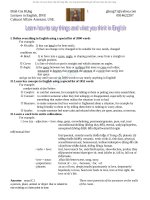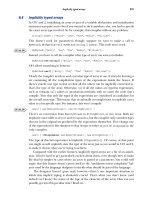BarCharts quickstudy what you wont learn in college
Bạn đang xem bản rút gọn của tài liệu. Xem và tải ngay bản đầy đủ của tài liệu tại đây (296.98 KB, 2 trang )
BarCharts, Inc.®
WORLD’S #1 QUICK REFERENCE GUIDE
Credit 101
Getting Your First Apartment/House
• Take a realistic look at your budget and what you can afford in terms of rent or a
mortgage. Keep in mind that most apartments/houses for rent require both first
month’s rent and last month’s rent when you sign the lease.
• Look around in neighborhoods that are most comfortable to you and are the closest
to meeting your specifications, such as having a younger population, safe
conditions, and being close to work.
• If you decide to have a roommate, one of the best ways to find one is to ask your
friends if they know of anyone who’s looking for a roommate. In addition, make
sure the roommate is compatible with you.
• You should always have at least three months worth of rent and living expenses in
your savings account. This protects you should any emergency arise, such as
unemployment, illness, etc.
• Some places will require anything from $500 to an additional month’s rent in terms
of a damage deposit; make sure you’re clear on what is considered damage versus
day-to-day wear and tear. You should also ask the same question regarding pet
deposits, which are in place to pay for any damage or loss of revenue to the
building owner due to animals on the property.
• Make sure you think about the potential cost of utilities, since most utility
companies will require a deposit if you’ve never had an account with them before;
also, if you’re setting up utilities for the first time in a new place, there’s usually a
“hook up” fee or administration fee. Shop around for places that include utility
costs in the monthly rent.
• Go through each room and think about the things you need on a daily basis, and
don’t leave anything out. For instance, in the kitchen, make sure you include small
appliances, pantry supplies, spices (these really add up), dishes, flatware, towels,
soap, dish rack, food staples, pots and pans, containers, garbage can, etc.
• As an idea, throw yourself a “moving out” party where guests can bring just one
item for your new home—it doesn’t have to be anything expensive, just something
useful. Make a list of things you need and send it with the invites.
• Eight out of 10 college students have and use
credit cards.
• Pay your bills on time.
• Keep the number of credit cards
you own to a minimum.
• Use your credit cards wisely.
• Check your credit reports annually;
there may be information that needs to
be corrected.
• You can request your credit report directly from the credit reporting agencies, or you
can use an online service like www.freecreditreport.com.
• Look for discrepancies: Information from someone with the same name or a similar
Social Security number may show up, or information can be incorrectly reported by
your credit card company.
• The only way to improve your credit rating is by establishing a good track record.
• Bad credit? Stop using those cards and start paying them off.
• If you have a number of credit cards, close at least some of them as you pay
them off.
Filling Out W-4 Forms
• Use Form W-4 to figure the right amount of federal income tax to have withheld
from your paycheck.
• Withholding allowance represents your total tax deductions divided by the
personal exemption rate.
• The withholding allowance is related to, but not the same as, the number of
dependents you can claim on your tax return.
• You may want to review your withholding every year, especially after finishing your
tax return. You can have more, or less, income tax withheld from your paycheck.
Budgeting
Interviews
•
•
•
•
•
•
•
•
•
•
• A budget lets you control your money, helps your entire family focus on common
goals, helps you prepare for emergencies or large or unanticipated expenses that
might otherwise knock you for a loop financially. It can also improve your
relationship by identifying and working towards common goals and reducing
arguments about money.
• Evaluate your current spending and set goals
that take into account your financial
objectives; track your spending to make sure
it stays within those guidelines. In general, if
you find yourself returning to the ATM more
than once a week or so, you need to examine
where that cash is going.
• If you use a personal-finance program such as
Quicken or Microsoft Money, the built-in budgetmaking tools can create your budget for you.
• Once you determine which categories of spending
can and should be cut (or expanded), concentrate on those categories and worry
less about other aspects of your spending.
• Aim to spend no more than 90 percent of your income. That way, you’ll have the
other 10 percent left to save for your big-picture items.
• When projecting the amount of money you can live on, don’t include dollars that
you can’t be sure you’ll receive, such as year-end bonuses, tax refunds, or
investment gains.
• As your annual income climbs from raises, promotions and smart investing, don’t
start spending for luxuries until you’re sure that you’re staying ahead of inflation.
It’s better to use those income increases as an excuse to save more.
Dress professionally.
Express yourself clearly with a strong voice and have good diction and grammar.
Look the interviewer in the eye (but don’t stare him or her down).
Look for an opportunity to talk about your résumé.
Equip yourself with a strong knowledge of the company.
Have prepared questions about the employer and position.
Don’t show a lack of interest or enthusiasm.
Ask for a business card for your records.
Thank the person for taking the time to meet with you.
Don’t forget to send a thank-you as part of your interview follow-up.
Learning to Cook
• Use cookbooks or find Web sites that feature basic recipes. The easiest recipes are
done with a crock pot.
• Take a cooking class or watch cooking shows on TV.
• To save money, look for stores and produce stands that sell high-quality ingredients
at inexpensive prices.
• Make sure you have the necessary ingredients and tools (silverware, measuring
cups, pots and pans) before you begin cooking.
• While you cook, experiment with different spices and techniques to see which
appeal to you best.
• As your cooking skills improve, use a new recipe once or twice a week.
1
Buying or Leasing a Car
Maintaining Your Vehicle
• Leasing allows consumers to always have a new or late-model car in the driveway.
A benefit of driving a late-model car is fewer repair bills.
• Leases are attractive to many car buyers because they can get more out of a car
for a lower monthly payment.
• Lessees only pay for the depreciation on the car, not the entire vehicle; they’re
renting the car for the length of the lease. When you buy, you pay for the entire
cost of a vehicle, regardless of how many miles you drive it.
• If you use your car for your job, leasing payments can be written off as a business
expense on your tax returns.
• You are able to avoid negative equity with leasing. In addition, you have the option
of not making a down payment, you pay sales tax only on your monthly payments
(in most states), and you pay a financial rate, called money factor, that is similar to
the interest rate on a loan.
• With leasing, though, you may be required to pay special lease-related fees and
possibly a security deposit that you don’t pay when you buy. Also, unlike buying,
leased cars are limited to a certain mileage determined by the number of years in
the lease; if the mileage is exceeded, the lessee will have to pay extra when the
lease is over.
• Unlike purchased cars, leased cars can’t be customized.
• Although you’ll own nothing at the end of a lease and have nothing “to show” for
the money you’ve put into it, what you don’t own is the same part of the car’s
original value — the depreciated part — that a buyer doesn’t own at the end of
his loan either. A car’s value depreciates the same amount whether it is leased or
purchased.
• With leasing, you may have the option of putting your monthly payment savings
into more necessary areas—such as investing in mutual funds, paying the
mortgage or buying groceries.
• Keeping your car in top running condition saves money.
• Keeping tires properly inflated can increase gas mileage.
• A well-maintained car releases a fraction of what a poorly maintained or
malfunctioning car emits. And, because vehicles on the road account for more than
25 percent of all air pollution nationwide, a little maintenance could go a long way
to cleaner air.
• Wash your car regularly—at least once a month. Things like bugs, bird droppings, or
limestone dripping can damage the paint, leaving permanent stains if not washed
off in time.
• At least once in a while, use a pressure wash—it removes the dirt from difficult-toreach areas (do this at a coin car wash station).
• Wash off all the places where the dirt and salt could be accumulated; for example,
behind moldings, inside wheel arches, under the bumpers, etc.
• Wax your car regularly. Wax helps to protect the paint, minimizing harm of
chemicals and protecting the paint from fading; plus, the car looks shiny.
• When the car is clean, all the moisture dries up quickly, but when it’s dirty, the
moisture accumulates in dirty areas, causing corrosion.
• If you live in an area with high humidity, or where the salt use is common in winter
months, undercoating and rust-proofing your car can be very helpful.
• Fix any small problem right away before it causes serious damage.
• Check the engine oil regularly—at least once a month or even more frequently if
you accumulate a lot of mileage.
• Try to avoid overheating your engine as that can cause serious damage.
• If you discover a coolant leak, have it fixed as soon as possible—it may cause
engine overheating.
• Most batteries nowadays are maintenance-free. All you check is battery terminals
that shouldn’t be loose or corroded.
Opening an Individual Retirement
Account (IRA)
Buying Car Insurance
• Decide which type of IRA is best for you—a Roth (which helps you save on taxes in
retirement) or traditional IRA (which helps you save on taxes currently).
• Start a discount brokerage account to house your long-term retirement savings.
Make sure your broker will place the bulk of your contribution toward retirement,
not to trading commissions.
• Officially open the account by downloading the application forms, signing them
and mailing them to the broker along with a check to fund your account.
Contribution limits to IRAs are $4,000.00, but the catch-up contribution limit for
those ages 50 or older is $1,000.
• Collision insurance pays for damage to your own vehicle resulting from a collision.
• Comprehensive coverage pays for property damage to your vehicle resulting from
anything other than a collision, such as theft, a break-in or malicious mischief.
• Uninsured or underinsured motorist (UM) coverage pays for your injuries if you are
struck by a hit-and-run driver or by someone who doesn’t have adequate
insurance—either because they have no coverage or because they don’t have
enough coverage to pay for your injuries. This type of coverage is limited to bodily
injury and does not cover property damage to your vehicle.
• Under no-fault coverage insurance, each person’s own insurance company pays for
his or her medical bills and lost wages—up to a certain dollar amount—regardless
of who was at fault. The advantage of no-fault insurance is prompt payment of
medical bills and lost wages; however, it doesn’t cover pain and suffering,
emotional distress, inconvenience or lost opportunities.
• Shop around for insurance. Just because your current company once offered you the
best deal doesn’t mean it’s still competitive.
• Increase your deductibles. For instance, if you agree to pay the first $500 or $1,000
of damage to your car, your collision insurance will cost less but still cover you for
a serious accident.
• Reduce your collision or comprehensive coverage on older cars. One rule of thumb
is to drop this coverage once the car is worth less than $2,500.
• Find out what discounts are available from your company (or another company).
• Find out which vehicles cost more to insure.
• If you’re looking to buy a new (or used) car, call your insurance agent and find out
which cars are expensive to repair, targeted by thieves or involved in a higher rate
of accidents. These vehicles all have higher insurance rates.
• Most of the time, you will pay less if all owners or drivers who live in the same
household are on one policy or at least are insured with the same company.
• You may be able to get a discount if you have both automobile and homeowner’s
or renter’s insurance from the same company.
Finding Health Insurance
• Think about which type of health insurance best suits you—whether you’re
working, self-employed, not working or in college.
• Find an insurance company that provides the best health insurance coverage for
your needs. Try to find out more about the financial strengths of each company and
compare key coverage areas.
• Have a list of questions ready for your provider. For example, ask the company
representative what’s excluded on the health insurance plan and the choice of
health care providers and/or doctors.
• Use a health insurance agent. They can help you quickly hone in on what’s best for
you, and because health insurance agents are independent from insurance providers,
they won’t have a hidden agenda of getting you to choose a particular plan.
• It is always best to review your health insurance plan with your employer health
insurance representative or the agent who helped you obtain the health insurance
plan, or thoroughly go over it yourself.
• Keep a personal medical log. When filing a health insurance claim, if you need to
challenge your insurance company’s decisions because a claim was denied, it’s
important to have a handy record of all procedures performed.
Get the Answers You Need . . .
Get the Skills
You Need
Do a
Computer - Based Training
2









